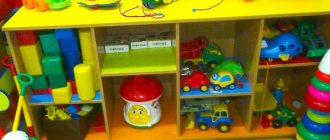A new GCD model plan that will save teachers from taking long notes
Educators must organize continuous educational activities (CED) in accordance with the requirements of the Federal State Educational Standard for Educational Education - in the form of joint partnership activities between an adult and children. However, the teacher often remains the only central figure in the course of educational activities. This is also indicated by the fact that the level of speech activity of children remains low even during speech development classes. The reason for this, to a large extent, is that educators traditionally use detailed notes from educational activities, where the picture of the lesson is built in the smallest detail, right down to the children’s possible answers. Sometimes the teacher does not allow the children to speak out because they are afraid that they will not have time to accomplish what they have planned. But the goal of GCD is to develop children, and not to carry out a planned script.
We suggest using a GCD plan model in your work. It gives an idea of the idea and logic of educational activities, reflects the sequence of actions and dialogue with children, but does not limit the teacher and children in improvisation, ideas, free choice and communication.
The plan-model of continuous educational activities takes from 2/3 to 1 page in volume. It does not contain educational material, poems, riddles, or games. The teacher takes them from card files and books, if necessary. It is easier for a teacher to retain such a plan in memory than a detailed outline or script. Writing such a plan takes less time on paperwork, which allows you to quickly prepare for educational activities.
The model plan is universal - another teacher can use it: take an idea and develop it at his own discretion.
What structure does the plan model have?
The model plan is of a framework nature, so it describes only the main elements of the GCD:
- stages of GCD, including goal setting;
- key issues;
- the situation of choice is an element of partnership interaction.
Goal setting. Here we mean the goal that the teacher sets for himself, i.e. this is the goal of educational activity. The model plan also includes a goal-setting step for children.
An example of GCD goal setting
The purpose of the GCD must be relevant. For example, a teacher organizes research activities in order to expand children’s understanding of an object or phenomenon. But preschoolers cannot work together: they conflict and cannot agree. What conclusion can be drawn? At this stage, it is more important to develop conflict-free communication skills in this particular group. That is, the goal of GCD is to organize a situation in which children develop conflict-free communication skills.
The modern educational process in preschool educational institutions should be variable and flexible. The teacher can build it taking into account the characteristics of the group and specific children.
The goal must be specific. It is advisable to have one goal. A common mistake of educators is the desire to embrace the immensity. They set so many goals for themselves that it is impossible to achieve them in the period of time allotted for educational activities. After all, it is necessary not only to realize the set goal, but also to monitor how successfully it is achieved. This does not mean that in the process of ECD, students develop only in one direction. Integration has deeply penetrated the educational process, and children develop in different directions. But teaching activities during educational activities will become more effective if the teacher focuses on one specific goal.
The goal must be measurable. The teacher will not be able to “measure” the achievement of 4-5 goals when conducting pedagogical observation. For example, how many children have made progress in mastering a skill? What level of independence do children show when completing practical tasks? How many children in the group follow the rules? And he can determine whether one goal has been achieved.
The goal must be achievable and related to a specific time frame. When a teacher plans educational activities, there is no need to set strategic goals. For example, it is impossible to develop cognitive interest in children in 20 minutes, but you can create conditions for this, organize an educational situation for the development of cognitive interest. In a subsequent analysis, the teacher will be able to list these conditions and confirm that the goal of the GCD has been achieved.
The goal of the GCD must be related to the goal of a higher order. The main principle of the planning system is to follow from strategic goals (targets) to tactical ones, from annual goals to monthly, weekly goals, specific goals and objectives of each educational activity. Goals and objectives must be interconnected.
GCD objectives should reflect the steps that the teacher plans to take to achieve the goal. Often, teachers’ tasks are the same goals, sometimes even broader than the goal itself, which is illogical. It is also wrong to replace goals and objectives with program content. Pedagogical activity cannot be aimless.
If goals and objectives are defined correctly, they can give a general idea of the planned GCD.
Motivation. Organization of the motivational stage also causes difficulties for educators. This can be judged by how monotonous the techniques they use in their notes are.
Teachers who work with preschool children must study methodological literature, the experience of colleagues, apply a creative approach to the process in order to evoke a lively response and genuine interest from students, and captivate them with various types of activities. It’s difficult to come up with an effective, motivating and mobilizing beginning every time, but you need to strive for this. Voluntary attention is just being formed in preschool age, and the teacher needs to try to ensure that the motive for children’s participation in educational activities is their direct interest, and not the instructions of an adult.
To do this, you need to constantly replenish your repertoire of motivational techniques. For each technique, you can come up with a short name so as not to describe it in detail in the plan.
Key questions. Key questions give the overall logic of the GCD. These are several related questions that encourage children to engage in productive dialogue. Their number is 4–5, sometimes more. They make you think, reason, act and ultimately lead to results.
Questions can be motivating (encouraging action), guiding, problematic, evaluative and reflective.
Most often, most of the questions that a teacher asks children are reproductive in nature, that is, the child is required to remember something, reproduce what he was taught. Such questions are also needed. But every GCD must also have open questions - those that imply detailed answers and their different options. This is especially important for older preschoolers. The more the teacher asks open-ended questions, the more interesting the dialogue he will build with the children.
The wording of key questions should be concise, clear and understandable. During the GCD, if the children do not immediately grasp the essence of the question, it is better to repeat it several times, addressing directly to individual students, rather than reformulating the question each time, confusing the children. You just need to give them time to think.
During the dialogue there will be more questions and answers, opinions, statements and reasoning from the teacher and children. But it is impossible and unnecessary to plan and register all of them if the teacher strives for free communication.
Collaboration. At this stage, as at the next, the teacher provides for the situation of choosing materials, type of activity, partner for activity and communication. Even if he does not provide the child with a wide choice, but only two options, this will allow the preschooler to make his own decision.
Independent work of children. This stage may not be reflected in the plan if the teacher does not expect independent work. It depends on the purpose of the GCD. But if he plans it, he must define his role at this stage. The teacher can:
- conduct individual work with children who need help;
- continue the dialogue with all students on the topic of GCD;
- give additional information;
- make notes to later add them to individual observation cards.
Reflection is the last and obligatory stage of GCD. Forming reflective skills as indicators of children’s personal growth is an important task for the educator. At the end of the educational activity, one can and should discuss:
- result - does it correspond to the goal, expectations at the beginning of the GCD (it can be collective (Did we succeed?) and individual (Did you succeed?);
- points that require correction (What would you like to correct?);
- content (What did you learn? What will you tell us about at home?);
- methods, sequence of activities (How did you achieve the result?)
- interaction during activities: attention to the interests of others, mutual assistance;
- attitude to what is happening, emotional background (what mood did you work in?);
- prospects for activity (What else can be done? What else would you like to do? Find out? Which method would you choose next time?).
GCD model plan template
HOW TO WATCH THE PRESENTATION
Scroll through the presentation by clicking the mouse, or use the arrows below
Electronic presentation about the GCD plan model
To make it more convenient for you to introduce educators to the GCD model plan, use comments on the slides.
What determines the volume of the model plan?
The GCD plan model, compared to the outline, has a more concise form. But even here the volume may vary. This depends on the purpose of the educational activity, its duration in different age groups, on the number of stages and their sequence, on the content of the activity and other factors, such as the teacher’s own understanding of what is the priority of a particular educational activity.
As an example, Appendices 1–2 present examples of GCD model plans on the topics “All work is honorable” in the senior group and “Why does a hare have long ears?” in the preparatory group.
Should I give up taking notes altogether?
There is no need to completely abandon notes and technological maps. With the help of technology maps, young teachers will be able to better understand the structure of teaching activities. They will also come in handy when educators learn new educational technologies.
A teacher needs a detailed outline of continuous educational activities to submit his work to a competition or publish it in a professional publication.
For daily work, a compact plan of educational activities is sufficient, which sets the main direction of the educational activity and gives the teacher and children the opportunity to improvise and communicate freely.
Annex 1
An example of a GCD model plan on the topic “All work is honorable”
Age group: senior.
Goal: to instill in children respect for the people who work in kindergarten and their work.
Tasks:
- clarify children’s ideas about the professions of kindergarten employees;
- pay attention to the features of these professions, show why they are interesting;
- create a situation in which children will show kindness, express gratitude and respect towards the kindergarten staff;
- lead to the conclusion that all professions are important.
Fragment of the NOD “All work is honorable” (E. Belozerova, teacher at MBDOU “Kindergarten No. 3” in Kalachinsk)
Appendix 2
An example of a GCD model plan on the topic “Why does a hare have long ears?”
Age group: preparatory.
Goals:
- to develop in children the ability to ask questions for cognitive purposes and experimentally find answers to them;
- expand children's understanding of the world around them;
- develop research skills.
Tasks:
- continue working with pictogram diagrams to formulate questions and draw conclusions;
- conduct experiments that demonstrate the functions of the hare's ear;
- record on an observation sheet how the ability to ask questions for educational purposes is being developed in the group’s students.
Fragment of the GCD “Why does a hare need ears?” (S. Trushina, senior teacher of MBDOU “Kindergarten No. 5” in Kalachinsk)
+





